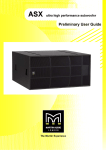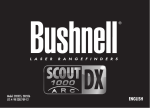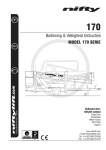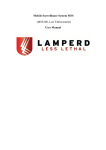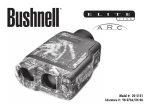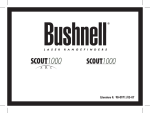Download Bushnell Elite 1600 Rangefinder Specifications
Transcript
Winchester .224 dia. 22-250 Rem, 55gr. Ballistic Silvertip at 3680fps Winchester .224 dia. 22-250 Rem, 55gr. PSP at 3680fps Federal Cartridge .227 dia. 270 Win, 150gr. Ballistic Tip at 3060fps Federal Cartridge .227 dia. 270 Win, 150gr. Partition at 3000fps Remington Arms .227 dia. 270 Win, 140gr. PSPCL Ultra at 2925fps Remington Arms .227 dia. 270 Win, 150gr. SPCL at 2850fps Winchester .227 dia. 270 Win, 150gr. Partition Gold at 2930fps Winchester .227 dia. 270 Win, 150gr. PP-Plus at 2950fps Federal Cartridge .308 dia. 30-06 Sprg, 180gr. AccuBond at 2700fps Federal Cartridge .308 dia. 30-06 Sprg, 180gr. Bear Claw at 2700fps Remington Arms .308 dia. 30-06 Sprg, 180gr. A-Frame at 2700fps Remington Arms .308 dia. 30-06 Sprg, 180gr. BRPT at 2700fps Winchester .308 dia. 30-06 Sprg, 180gr. FailSafe at 2700fps Winchester .308 dia. 30-06 Sprg, 180gr. Partition Gold at 2750fps Federal Cartridge .308 dia. 300 WSM, 180gr. AccuBond at 2960fps Federal Cartridge .308 dia. 300 WSM, 180gr. Bear Claw at 3025fps Winchester .308 dia. 300 WSM, 180gr. Ballistic Silvertip at 3010fps Winchester .308 dia. 300 WSM, 180gr. FailSafe at 2970fps Remington Arms .308 dia. 300 R.S.A.U.M., 180gr. PSPCL Ultra at 2960fps Remington Arms .308 dia. 300 Wby Mag, 180gr. PSPCL at 3120fps H G F F E D E E D D D D D D F F F F E F Above are a few of the most popular calibre/load combinations. A complete list of approximately 2000 calibre and load combinations can be found on Bushnell’s website (www.bushnell.com). After you have determined which ballistic group corresponds to your calibre and load, select this ballistic group (see MENU SETUP above). The internal formula will determine amount of bullet-drop/holdover in inches or centimetres based upon distance, angle and ballistics of your calibre and load. This state-of-the-art digital technology allows the hunter or shooter to know precisely where to hold for an effective shot. This information should be treated as a helpful guide or tool and in no way should it ever replace practice and familiarity with your rifle, cartridge and load. We encourage practice shooting at different ranges so you know how your rifle, cartridge and load will perform under various conditions. Always know what is behind your bullet; if you don’t know, don’t take the shot. EXAMPLE You have a 300 WSM and are shooting the following Winchester brand load: 180gr. Ballistic Silver Tip bullet at 3010 FPS muzzle velocity. This combination falls under Ballistic Group “F”. After setting the rangefinder to ballistic group “F”, go to the range and sight in your riflescope at 100yds. If you then take a shot at a target at 317yds, the bullet-drop will be 9ins. If the shot is at an angle of 27° upward, then the corrected bullet-drop will be 8ins. WHAT IF YOUR CALIBRE IS NOT LISTED? While we have taken great care to include as many calibres and brand names in our ballistics tables, new loads are always being developed. In addition, some shooters load their own ammunition with unique ballistic characteristics. If you cannot find your load in our ballistic tables, you can still use the bullet-drop feature of the laser rangefinder. As above, sight in your rifle at 100yds. Then shoot the rifle, without adjusting the riflescope, at 300yds. Measure the bullet-drop from point of aim. Using this drop, select the ballistic group from below. If you will be shooting longer distances then you may want to check the bullet-drop at 500yds. Because there is enormous variation in rifle barrels, chambers and hand loads, you should thoroughly test the ballistic setting before actual hunting. You may need to move up or down one group depending upon your tests. If Bullet-drop is @300yds Use: @300m @500yds @500m A 25-31in 63-79cm 114-146in 291-370cm C 16-20in 40-50cm 72-88in 182-225cm B D E F G H 20-25in 13-16in 12-13in 10-12in 8-10in < 8in 50-63cm 34-40cm 30-34cm 25-30cm 20-25cm < 20cm 88-114in 61-72in 55-61in 47-55in 39-47in < 39in 225-291cm 155-182cm 139-155cm 119-139cm 99-119cm < 99cm RAINGUARD HD The outer surfaces of the objective and eyepiece lenses are coated with RainGuard HD. This is Bushnell’s permanent, patented, water repellant lens coating that prevents fogging by causing condensation from rain, sleet, snow or even your own breath to bead up into much smaller droplets than on standard coatings. Smaller uniform droplets scatter less light which results in a clearer, brighter view. CLEANING Gently blow away any dust or debris on the lenses (or use a soft lens brush). To remove dirt or fingerprints, clean with a soft cotton cloth, rubbing in a circular motion. Use of a coarse cloth or unnecessary rubbing may scratch the lens surface and eventually cause permanent damage. For a more thorough cleaning, photographic lens tissue and photographic-type lens cleaning fluid or isopropyl alcohol may be used. Always apply the fluid to the cleaning cloth - never directly on the lens. TRIPOD MOUNT Moulded into the bottom of your Elite 1600 ARC is a threaded tripod mount that will allow you to attach a tripod for a more stable operation during long periods of use. SPECIFICATIONS: Weight: 10oz Ranging accuracy: ±1yd Range: 5 - 1600yds / 5 - 1463m Magnification: 7x Objective diameter: 26mm Optical coatings: Fully multi-coated RainGuard HD coating Display: VDT Power source: 3V Lithium (included) Field of view: 340ft @ 100yds / 104m @ 1000m Extra long eye relief: 19mm Exit pupil: 3.7mm Waterproof Built-in tripod mount Includes battery, carry case and strap TROUBLESHOOTING TABLE If the unit does not turn on - Display does not illuminate: • Depress the POWER button. • Check and, if necessary, replace battery. If the unit powers down (display goes blank when attempting to power the laser): • The battery is either weak or low quality. Replace the battery with a good quality 3V Lithium battery (CR123). If target range cannot be obtained: • Make sure Display is illuminated • Make sure that the power button is depressed • Make sure that nothing, such as your hand or finger, is blocking the objective lenses (lenses closest to the target) that emit and receive the laser pulses • Make sure unit is held steady while depressing power button NOTE: The last range reading does not need to be cleared before ranging another target. Simply aim at the new target using the LCD’s reticle, depress the power button and hold until new range reading is displayed. FCC NOTE This equipment has been tested and found to comply with the limits for a Class B digital device, pursuant to part 15 of the FCC Rules. These limits are designed to provide reasonable protection against harmful interference in a residential installation. This equipment generates, uses and can radiate radio frequency energy and, if not installed and used in accordance with the instructions, may cause harmful interference to radio communications. However, there is no guarantee that interference will not occur in a particular installation. If this equipment does cause harmful interference to radio or television reception, which can be determined by turning the equipment off and on, the user is encouraged to try to correct the interference by one of the following measures: • Reorient or relocate the receiving antenna. • Increase the separation between the equipment and receiver. • Connect the equipment into an outlet on a circuit different from that to which the receiver is connected. • Consult the dealer or an experienced radio/TV technician for help. Shielded interface cable must be used with the equipment in order to comply with the limits for a digital device pursuant to Subpart B of Part 15 of the FCC Rules. Specifications, instructions and the operation of these products are subject to change without any notice or obligation on the part of the manufacturer. FDA Eye Safety Class 1 laser product in accordance with IEC 60825-1:2007. Complies with 21 CFR 1040.10 and 1040.11 for laser products except for deviations pursuant to Laser Notice No. 50, dated June 24, 2007. Caution: There are no user controls, adjustments or procedures. Performance of procedures other than those specified herein may result in access to invisible laser light. York Survey Supply Centre, Prospect House, George Cayley Drive, Clifton Moor, York, England YO30 4XE Tel: +44 (0) 1904 692723 Fax: +44 (0) 1904 690385 E-Mail: [email protected] www.yorksurvey.co.uk Ref:.. \operat98\instructions 15\431590.qxp 05-01-15 Elite 1600 ARC Laser Rangefinder Code: 431590 Operating Instructions ©York Survey Supply Centre 2015 Elite 1600 ARC Laser Rangefinder The ultimate in innovation, the new Elite 1600 ARC combines the best of a compact monocular with the new Vivid Display Technology. Every range is displayed with rich contrast and stunning clarity no matter what the lighting conditions are. At the push of a button, it displays the exact distance to your target from 5 to 1,600 yards. With built-in Angle Range Compensation, BOW Mode delivers line-of-sight, degree of angle and true horizontal distance and RIFLE Mode provides line-of-sight, degree of angle and bullet-drop/holdover data. With new RainGuard HD anti-fog coating and a fully waterproof design to ensure reliability and clarity in all conditions, it’s the best of all worlds. This booklet will help you achieve optimum performance by explaining its adjustments and features as well as how to care for this device. To ensure optimal performance and longevity, please read these instructions before using your Elite 1600 ARC laser rangefinder. HOW OUR DIGITAL TECHNOLOGY WORKS The Elite 1600 ARC emits invisible, eye safe, infrared energy pulses. The Elite 1600 ARC’s Advanced Digital microprocessor and ASIC chip (Application-Specific Integrated Circuit) results in instantaneous and accurate readings every time. Sophisticated digital technology instantaneously calculates distances by measuring the time it takes for each pulse to travel from the rangefinder to the target and back. RANGING ACCURACY The ranging accuracy of the Elite 1600 ARC is plus or minus one yard/metre under most circumstances. The maximum range of the instrument depends on the reflectivity of the target. The maximum distance for most objects is 1000yds/914m while for highly reflective objects the maximum is 850yds/777m. Note: You will get both longer and shorter maximum distances depending on the reflective properties of the particular target and the environmental conditions at the time the distance of an object is being measured. The colour, surface finish, size and shape of the target all affect reflectivity and range. The brighter the colour, the longer the range. White is highly reflective, for example, and allows longer ranges than the colour black, which is the least reflective colour. A shiny finish provides more range than a dull one. A small target is more difficult to range than a larger target. The angle to the target also has an effect. Shooting to a target at a 90° angle (where the target surface is perpendicular to the flight path of the emitted energy pulses) provides good range while a steep angle on the other hand, provides limited ranging. In addition, lighting conditions (e.g. the amount of sunlight) will affect the ranging capabilities of the unit. The less light (e.g. overcast skies) the farther the unit’s maximum range will be. Conversely, very sunny days will decrease the unit’s maximum range. GETTING STARTED OPERATIONAL SUMMARY While looking through the Elite 1600 ARC, depress the power button once to activate the Vivid Display (LCD). Place the aiming circle (located in the centre of the field of view) upon a target at least 5 yards away, depress and hold the power button down until the range reading is displayed near the bottom of the in-view display. Crosshairs surrounding the aiming circle indicate that the laser is being transmitted. Once a range has been acquired, you can release the power button. The crosshairs surrounding the aiming circle will disappear once the power button has been released (i.e. the laser is no longer being transmitted). Note: Once activated, the display will remain active and display the last distance measurement for 3 seconds. You can depress the power button again at any time to distance to a new target. As with any laser device, it is not recommended to directly view the emissions for long periods of time with magnified lenses. The maximum time the laser is transmitted (fired) is 10 seconds. To re-fire, press the button down again. VIVID DISPLAY INDICATORS Your Elite 1600 ARC Vivid Display incorporates the following illuminated indicators: Angle Range Compensation Modes Rifle Mode (1) Bow Mode (2) Battery Life Indicator (3) Aiming Circle (4) Active Laser (5) Targeting Modes Bullseye Mode (6) Brush Mode (7) Primary Numeric Display displays Line-of-Sight Distance (8) Holdover / Bullet-drop measure for Rifle Mode MOA (9) CM (10) IN (11) SD = Variable Sight-In Distance (12) Secondary Numeric Display (13) (Toggles from Degree of Angle to Holdover / Bullet-drop for Rifle Mode) (Toggles from Degree of Angle to True Horizontal Distance for Bow Mode) ANGLE RANGE COMPENSATION The Elite 1600 ARC is an advanced premium laser rangefinder monocular featuring a built-in accelerometer-based inclinometer that digitally displays the exact angle from Ref:.. \operat98\instructions 15\431590.qxp 05-01-15 -90 to +90° of elevation and is ±1.0° accurate. The Bushnell Elite 1600 ARC solves a problem hunters have been faced with for years. The problem: Bow and rifle hunters have struggled with extreme uphill and downhill angles because of how these angles alter true horizontal distance to your target. The solution: ARC’s integrated inclinometer provides elevation angle to allow for distance compensation when targeting objects that are either uphill or downhill. This data is then combined with internal algorithmic ballistic formulas. ARC (ANGLE RANGE COMPENSATION) MODES Bow Mode: Displays line of sight distance, degree of elevation and true horizontal distance from 10-99yds/m and a maximum inclination of ±90°. Rifle Mode: Calculates and displays the amount of bullet-drop, at the target in inches, centimeters or MOA. The amount of bullet-drop is determined by the line of sight, degree of elevation, along with the specific ballistic characteristics of the calibre and ammunition load. When you range your target, the line of sight, degree of elevation and bullet-drop/holdover in inches, centimetres or MOA will be displayed from 100 to 800yds/m with a maximum inclination of ±90°. One of eight ballistic groups (identified as A, B, C, D, E, F, G and H) for centre fire rifles and two ballistic groups (identified as I and J) for Black Powder / Muzzleloaders can be selected by the user, with each formula representing a given combination of calibre and loads. The ballistic groups are selected by the user in the SET-UP menu. Regular Mode: This mode does not provide any degree of elevation or compensated distance, but instead, line of sight distance only. BATTERY LIFE INDICATOR Battery indicator: Within the display is a battery icon Full charge 2/3 battery life remaining 1/3 battery life remaining Battery indicator blinks - battery needs to be replaced and unit will not be operable. INSERTING THE BATTERY Remove the battery cap by lifting the battery door tab and then rotating counter-clockwise. Insert a CR123 3V Lithium battery into the compartment, negative end first, then replace the battery cap. NOTE: It is recommended that the battery be replaced at least once every twelve months. UNIT OF MEASURE OPTIONS The Elite 1600 ARC can be used to measure distances in yards or metres. The unit of measure indicators are located in the lower right portion of the LCD. ACTIVE LASER Crosshairs surrounding the aiming circle indicate that the laser is being transmitted. Once a range has been acquired, you can release the power button. The crosshairs surrounding the circle will disappear once the power button has been released (i.e. the laser is no longer being transmitted). SELECTIVE TARGETING MODES The Elite 1600 ARC was especially designed with hunters in mind. The selective targeting modes allow you to adjust the performance parameters of the unit to suit your specific situation and environment. To move from one mode to another, press the POWER button once to turn on the unit. While looking through the eyepiece, press the MODE button and quickly release. The different targeting modes available and mode indicators are listed below: Standard with Automatic SCAN (LCD Indicator - none) This setting allows most targets to be distanced up to 1600yds. Used for moderately reflective targets that are typical of most distancing situations. The minimum distance in the standard mode is 10yds. To use the Automatic SCAN feature, simply hold down on the POWER button for approximately 3 seconds and move the rangefinder from object to object while leaving the power button depressed. Automatic SCAN will allow the range to be continuously updated as multiple objects are targeted. Bullseye (LCD Indicator ) This advanced mode allows easy acquisition of small targets and game without inadvertently getting distances to background targets that have stronger signal strength. When more than one object has been acquired, distance of the closer object will be displayed and a crosshair will surround the Bullseye Indicator informing the user that the distance to the closer object is being displayed in the LCD. Once in this mode, press the POWER button to turn the unit on. Next, align the aiming circle onto the object (i.e. deer) that you want to distance to. Next press and hold the POWER button and move the laser slowly over the deer until crosshairs surround the Bullseye Indicator. If the laser beam recognised more than one object (i.e. deer and background trees), distance of the closer object (i.e. deer) will be displayed and crosshairs will surround the Bullseye Indicator informing the user that distance to the closer object is being displayed in the LCD (figure 1). There may be times when the laser beam only sees one object in its path. In this case, the distance will be displayed, but because more than one object was not acquired, crosshairs will not surround the Bullseye Indicator. TIP: While pressing the POWER button, you can move the device slowly from object to object and intentionally force the laser to hit multiple objects to ensure that you are only displaying the closest of the objects recognised by the laser. Brush (LCD Indicator ) This advanced mode allows objects such as brush and tree branches to be ignored so that distance only to background objects are displayed. When more than one object has been acquired, distance to the further object will be displayed and a circle will surround the Brush Indicator informing the user that distance of the farthest object is being indicated in the LCD. Once in this mode, press the POWER button to turn the unit on. Next, align the aiming circle onto the object that you want to distance to. Next press and hold the POWER button and move the laser slowly over the deer until a circle surrounds the Brush Indicator. If the laser beam recognised more than one object (i.e. close up tree branch and a deer in the background), distance of the further object (i.e. deer) will be displayed and a circle will surround the Brush Indicator informing the user that distance to the farther object is being displayed (figure 2). There may be times when the laser beam only sees one object in its path. In this case, the distance will be displayed, but because more than one object was not acquired, the circle will not surround the Brush Indicator. TIP: While pressing the POWER button, you can move the device slowly from object to object and intentionally force the laser to hit multiple objects to ensure that you are only displaying the farthest of the objects recognised by the laser. When the unit automatically powers down, operation will always return to the normal operation (i.e. away from SETUP) with the last used ARC mode active (i.e BOW, RIFLE or REGULAR) along with the last used TARGETING modes active (Standard SCAN, BULLSEYE or BRUSH). If the unit turns off while in the SETUP menu, the unit will always return to the last mode(s) still active. Once the range is displayed, continue to hold the POWER button down for approximately 2 seconds while holding the aiming circle on the object and keeping the unit as steady as possible so as to allow the inclinometer enough time to measure angle. Then release the POWER button. Once you have released the power button, the line of sight will be displayed for approximately 1.5 seconds, and will then automatically switch to the compensated range. The line of sight distance, unit of measure and automatic toggle from degree of angle to compensated distance will continue for 5 seconds at which time the display will automatically shut off. BOW MODE EXAMPLE Line of sight is 32yds, angle is -44° and the Angle Range Compensated distance is 23yds. Instead of shooting as 32yds, shoot as 23yds. If you were to shoot as if 32yds, you would shoot over the top of the deer because of the severe angle. Once the device has shut off, the unit will always default back to the last targeting mode used. MENU SETUP - SELECTION OF DISPLAY BRIGHTNESS, BOW, RIFLE, REGULAR MODES, SIGHT-IN DISTANCE AND BALLISTIC CORRECTION DISPLAY BRIGHTNESS Vivid Display Technology dramatically improves contrast, clarity and light transmission while increasing brightness of the digital readout, making distance readings legible in low light. There are four intensity settings to choose from and this is the first setting within the SETUP menu. Press the MODE button for 3 seconds to get into the SETUP menu. The existing brightness setting will be flashing (i.e. brt1, brt2, brt3 or brt4), pressing the MODE button will toggle between the four brightness settings. brt1 is the lowest intensity while brt4 is the brightest. Simply press the MODE button until the desired brightness setting is displayed and select by pressing and releasing the POWER button. There are two ARC (Angle Range Compensation) modes and one REGULAR mode. The two ARC modes are BOW mode and RIFLE mode. To select between these modes, first turn the unit on by pressing and releasing the POWER button. Next, press and hold the MODE button for three seconds to get into the SETUP menu. The brightness is displayed first and can be changed by pressing the MODE button or accepted by pressing the POWER button. Then press the power button until you see the existing compensation mode interdicted by either the “Bow” symbol, the “Rifle” symbol lit with one of the ballistic groups (A through J) displayed and flashing, or no indicators lit and the message rEG flashing. The modes can be cycled through in a circular fashion by pressing and releasing the mode button. The order of modes is as follows: BOW, RIFLE A, RIFLE B, RIFLE C, RIFLE D, RIFLE E, RIFLE F, RIFLE G, RIFLE H, RIFLE I, RIFLE J, REG, etc. When the bow selection is displayed, the “Bow” icon will flash and when a rifle selection is displayed, the “Rifle” icon and ballistic group will be flashing. When the rEG is displayed, the message rEG will flash within the display. Once the desired distance compensation mode is displayed, select it by pressing and releasing the POWER button. Following this selection, the current unit of measure, “Y” for yards or “M” for metres will flash in the display and the SETUP icon is still lit. Pressing the MODE button will toggle the unit of measure. When the desired unit of measure is displayed, press the POWER button to accept the unit of measure. If the user chooses RIFLE mode, and after having determined the unit of measure, the user has the following options: 1. Variable Sight-In (VSI) - Allows the rifle hunter to choose from four sight-in distances (100, 150, 200 or 300 yards or metres) and provides holdover/bullet-drop data in inches, centimetres or MOA. The “SD” (Sight-in Distance) indicator will turn on and the current Sight-in Distance number will blink within the display (i.e. 100, 150, 200 or 300). The Sight-in Distance options can be cycled through in a circular fashion by pressing and releasing the mode button. Once the desired Sight-in Distance is displayed, select it by pressing and releasing the power button. 2. And finally, if RIFLE mode was chosen, and as long as unit of measure and a sight-in distance was selected, you have the option of determining how you would like holdover/bullet-drop displayed. If measurement units are in yards, you will be able to choose between inches or MOA. The “CM” for centimetres or “IN” for inches will flash in the display and the SETUP icon is still lit. Once the desired ballistic measure is displayed, select it by pressing and releasing the power button. If units of measure selected previously was Metres, then your holdover/bullet-drop will automatically be displayed in centimetres. Upon returning to the normal operating menu, the current compensation mode and unit of measure will be identified in the display as indicated below. If in BOW mode, the line of sight distance will display in the primary numeric display and the inclination and horizontal distance will display in the secondary numeric displays. Bushnell determined through extensive testing and interviews with high-profile bow-hunting experts that multiple bow ballistic groups were not necessary. Bow-hunters want to know true horizontal distance because that is how they practice shooting and, once they confidently know that, they can make any necessary adjustments. Giving the bow-hunter anything else other than horizontal distance creates additional confusion and uncertainty. Many people mistakenly believe that uphill shots perform differently from downhill shots because of gravity. However it is not due to gravity, but more an aberration of the sighting system used on bows. The sighting pin on a bow resides several inches above the mechanical axis of the arrow. For example, when one is aiming 23° up an incline, the arrow is at a different angle. RIFLE MODE EXAMPLE Line of sight is 376yds, angle is -33° and the bullet-drop/holdover is 28ins. ARC not only takes into account ballistic data based off your calibre and load from distances of 100-800yds but also compensates for any uphill and downhill angles which also affect bullet-drop. If in RIFLE mode, the ballistic group will be displayed in the bullet-drop numeric field anytime that the primary numeric display is showing dashes (i.e. no target acquired). When a target is acquired in RIFLE mode, the line sight distance will display in the secondary numeric displays. The “IN” icon (i.e. inches) will light next to the bullet-drop numeric display if the unit of measure is set to yards (Y). If the unit of measure is set to metres (M), the bullet-drop will be calculated and displayed in centimetres and the “IN” icon will be turned off. If the bullet-drop/holdover reads “lo” this means the compensated distance is beyond what can be displayed or beyond ballistic calculations and user will need to hold low. REGULAR MODE This mode does not provide any degree of elevation or compensated distance, but instead, line of sight distance only. This will still appear below the line of sight numeric display, but there will not be any information displayed in the secondary numeric display. KNOWING WHICH BALLISTIC GROUP TO SELECT Bushnell engineers have worked with Sierra Bullets’ ballistic programs and grouped many of the most popular calibres and loads into eight ballistic groups (A, B, C, D, E, F, G, H). Once you know what calibre and load you are shooting simply look through the chart to determine which one of the eight ballistic groups match with your particular load and calibre. For Muzzleloaders, we have worked with PowerBelt Bullets to incorporate ballistic data into two ballistic groups (I and J). POPULAR CALIBRE & LOAD COMBINATIONS Federal Cartridge .224 dia. 22-250 Rem, 55gr. Bear Claw at 3600fps Federal Cartridge .224 dia. 22-250 Rem, 60gr. Partition at 3500fps Remington Arms .224 dia. 22-250 Rem, 50gr. V-Max at 3725fps Remington Arms .224 dia. 22-250 Rem, 55gr. PSP at 3680fps G F H G ©York Survey Supply Centre 2015


